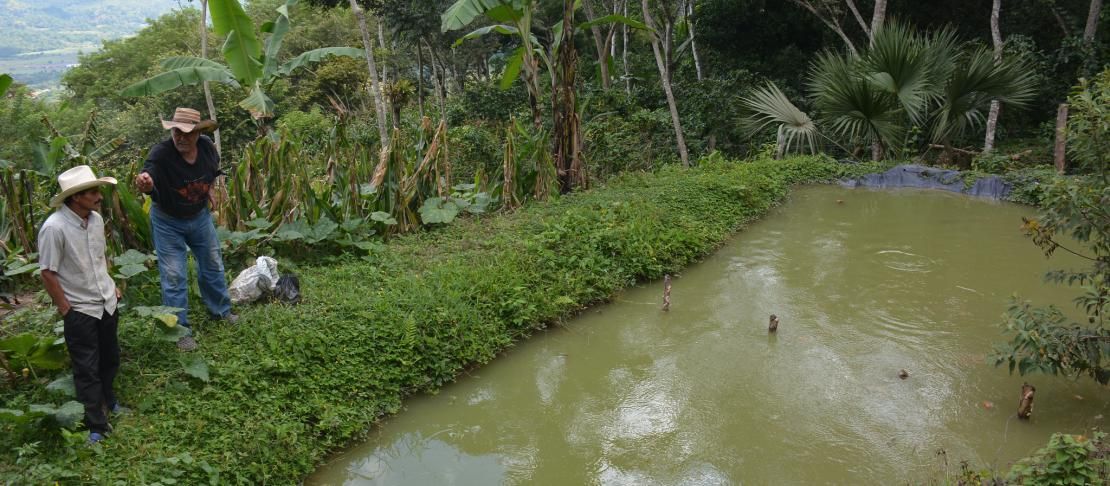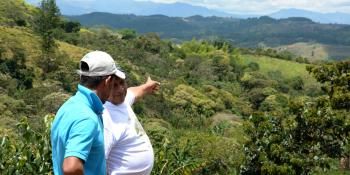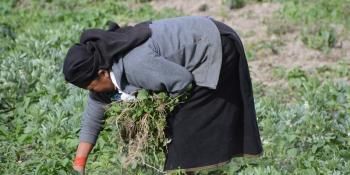Farmers from CSV Santa Rita work towards their dream farm

Farmers in the Climate-Smart Village of Santa Rita imagine their dream farms while learning how to manage them under climate change.
The farmers in the Climate-Smart Village (CSV) in Santa Rita, located in the department of Copán, Honduras, experienced heavy rains in August. However, by employing climate-smart agriculture (CSA) options, and monitoring their crops and the weather, they continued to cultivate their land. As a result, the farmers had a very succesful corn harvest this year.
The coming months, the farmers will continue to learn how to use climate services and CSA options to build their resilient 'dream farms'. For example, they are learning how to use weather forecasts to make decisions about their crops using the Participatory Integrated Climate Services for Agriculture (PICSA) approach. The PICSA approach is used to facilitate informed decisions by farmers based on accurate, location specific, climate and weather information. It enables farmers to develop their plans for their farms and decide what CSA options to prioritize for their plots.
Learning with PICSA
One of the first steps in the implementation of PICSA in Santa Rita was to develop a map of a potential reallocation of resources. By creating this map, farmers can analyze the current state of their farm, and imagine what their ideal farm would look like. The map also ensures that farmers always have a clear overview of their resources, which helps them to prioritize the most convenient CSA practices to increase productivity and improve food security. The farmers were supported in this process by the CGIAR Research Program on Climate Change, Agriculture and Food Security (CCAFS), and its local partner the Mennonite Social Action Commission (CASM).
The implementation of PICSA helps farmers to gain new insights into the potential of their farms."Now I have the farm cultivated with cloths for coffee, but in my dream farm I want to plant banana, automate shade management and have a new plot for growing corn," explains one of the farmers in Aldea Nueva, one of the communities that is part of the CSV.

Aldea Nueva farmers have a pluviometer that allows them to collect additional data that helps the farmers to make well-informed decisions about their farms. Together with CASM, they use this data to build an agroclimatic bulletin that is shared with other farmers. They also have a group called “Climate Monitors” where farmers can share all the climate information they have access to. “One of the advantages of PICSA is that it helps the farmers understand climate behavior. The tool facilitates sharing climate information offered by institutions into something more digestible for producers," said Osmán Alvarez, agriculture facilitator in CASM.
Looking towards the future
Currently, different CSA options such as fish reservoirs, shade coffee, rainwater crops, organic fertilizer, home gardens with irrigation, and live barriers, among others, have been implemented in Santa Rita. These CSA practices help farmers to build a climate-smart farm that is more resilient to the effects of climate change.
“It is interesting to highlight that many of the CSA options that have been adopted in Santa Rita, were in fact the result of the knowledge exchange with the producers from Cauca’s CSV in Colombia. For example, as a result of the knowledge exchange, producers in Santa Rita are now using fish reservoirs and home gardens with irrigation,” says Jesús David Martínez, coordinator of the CSV in Latin America.
By the end of this year, a total of four communities in the CSV of Santa Rita will be working on understanding, prioritizing and implementing CSA practices for their specific contexts. This, together with the implementation of PICSA, will support farmers to realize their dream farms.
Read more:
- News update: Face to face: Colombia-Honduras knowledge exchange on adaptation within the Climate-Smart Villages framework
- News update: Productores de Honduras y Colombia intercambian experiencias y conocimientos en adaptación al cambio climático
Lauren Sarruf Romero is the Communications Officer for CCAFS Latin America.



